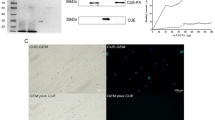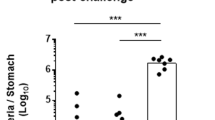Abstract
Helicobacter pylori (H. pylori) infection causes peptic ulcers, gastric adenocarcinoma, and mucosa-associated lymphoid tissue (MALT) lymphoma. The eradication of H. pylori might be an effective means of preventing gastric cancer. A dual-antigen epitope and dual-adjuvant vaccine called CTB-UE-CF (CCF) was constructed by combining a multi-epitope vaccine CTB-UE with a novel chimeric flagellum (CF) to simultaneously activate Toll-like receptor (TLR) 5-agonist activity and preserve the immunogenicity of H. pylori flagellum FlaA. The evaluation of efficacy to reduce H. pylori colonization was performed using BALB/c mice by oral immunization with a triple dose of this vaccine strain. Two weeks after the last immunization, mice were sacrificed to determine specific antibody levels and proinflammatory cytokine production. To determine the presence of H. pylori, we detected the number of H. pylori by real-time quantitative PCR (qPCR) and measured the urease activity in the gastric tissue. The results showed that the immunogenicity and mucosal immune responses of CCF performed significantly better than those of CTB-UE. This dual-antigen epitope and dual-adjuvant system might greatly contribute to the development of a safe and efficient therapeutic vaccine for humans against H. pylori infection.




Similar content being viewed by others
References
Andersen-Nissen E, Smith KD, Strobe KL, Barrett SL, Cookson BT, Logan SM, Aderem A (2005) Evasion of toll-like receptor 5 by flagellated bacteria. Proc Natl Acad Sci U S A 102(26):9247–9252
Eaton KA, Morgan DR, Krakowka S (1992) Motility as a factor in the colonisation of gnotobiotic piglets by Helicobacter pylori. J Med Microbiol 37(2):123–127
Ferrero RL, Lee A (1991) The importance of urease in acid protection for the gastric-colonising bacteria Helicobacter pylori and Helicobacter felis sp. nov. Microb Ecol Health Dis 4(3):121–134
Gewirtz AT, Yu Y, Krishna US, Israel DA, Lyons SL, Peek Jr RM (2004) Helicobacter pylori flagellin evades toll-like receptor 5-mediated innate immunity. J Infect Dis 189(10):1914–1920
Gómez-Duarte OG, Lucas B, Yan ZX, Panthel K, Haas R, Meyer TF (1998) Protection of mice against gastric colonization by Helicobacter pylori by single oral dose immunization with attenuated Salmonella typhimurium producing urease subunits A and B. Vaccine 16(5):460–471
Graham DY, Shiotani A (2008) New concepts of resistance in the treatment of Helicobacter pylori infections. Nat Clin Pract Gastroenterol Hepatol 5(6):321–331
Guo L, Li X, Tang F, He Y, Xing Y, Deng X, Xi T (2012a) Immunological features and the ability of inhibitory effects on enzymatic activity of an epitope vaccine composed of cholera toxin B subunit and B cell epitope from Helicobacter pylori urease A subunit. Appl Microbiol Biotechnol 93(5):1937–1945
Guo L, Liu K, Xu G, Li X, Tu J, Tang F, Xing Y, Xi T (2012b) Prophylactic and therapeutic efficacy of the epitope vaccine CTB-UA against Helicobacter pylori infection in a BALB/c mice model. Appl Microbiol Biotechnol 95(6):1437–1444
Guo L, Yin R, Liu K, Lv X, Li Y, Duan X, Chu Y, Xi T, Xing Y (2014) Immunological features and efficacy of a multi-epitope vaccine CTB-UE against H. pylori in BALB/c mice model. Appl Microbiol Biotechnol 98(8):3495–3507
Guy B, Hessler C, Fourage S, Haensler J, Vialon-Lafay E, Rokbi B, Millet MJ (1998) Systemic immunization with urease protects mice against Helicobacter pylori infection. Vaccine 16(8):850–856
He Q, Wang JP, Osato M, Lachman LB (2002) Real-time quantitative PCR for detection of Helicobacter pylori. J Clin Microbiol 40(10):3720–3728
Huleatt JW, Jacobs AR, Tang J, Desai P, Kopp EB, Huang Y, Song L, Nakaar V, Powell TJ (2007) Vaccination with recombinant fusion proteins incorporating Toll-like receptor ligands induces rapid cellular and humoral immunity. Vaccine 25(4):763–775
Lee CK, Weltzin R, Thomas Jr WD, Kleanthous H, Ermak TH, Soman G, Hill JE, Ackerman SK, Monath TP (1995) Oral immunization with recombinant Helicobacter pylori urease induces secretory IgA antibodies and protects mice from challenge with Helicobacter felis. J Infect Dis 172(1):161–172
Leying H, Suerbaum S, Geis G, Haas R (1992) Cloning and genetic characterization of a Helicobacter pylori flagellin gene. Mol Microbiol 6(19):2863–2874
Lv X, Yang J, Song H, Li T, Guo L, Xing Y, Xi T (2014a) Therapeutic efficacy of the multi-epitope vaccine CTB-UE against Helicobacter pylori infection in a Mongolian gerbil model and its microRNA-155-associated immuno-protective mechanism. Vaccine 32(41):5343–5352
Lv X, Song H, Yang J, Li T, Xi T, Xing Y (2014b) A multi-epitope vaccine CTB-UE relieves Helicobacter pylori-induced gastric inflammatory reaction via up-regulating microRNA-155 to inhibit Th17 response in C57/BL6 mice model. Hum Vaccin Immunother 10(12):3561–3569
O’Connor A, Vaira D, Gisbert JP, O’Morain C (2014) Treatment of Helicobacter pylori infection 2014. Helicobacter Suppl 1:38–45
Ottemann KM, Lowenthal AC (2002) Helicobacter pylori uses motility for initial colonization and to attain robust infection. Infect Immun 70(4):1984–1990
Papastergiou V, Georgopoulos SD, Karatapanis S (2014) Treatment of Helicobacter pylori infection: past, present and future. World J Gastrointest Pathophysiol 5(4):392–399
Peek Jr RM, Crabtree JE (2006) Helicobacter infection and gastric neoplasia. J Pathol 208(2):233–248
Schülke S, Waibler Z, Mende MS, Zoccatelli G, Vieths S, Toda M, Scheurer S (2010) Fusion protein of TLR5-ligand and allergen potentiates activation and IL-10 secretion in murine myeloid DC. Mol Immunol 48(1–3):341–350
Shukla SK, Prasad KN, Tripathi A, Ghoshal UC, Krishnani N, Nuzhat H (2011) Quantitation of Helicobacter pylori ureC gene and its comparison with different diagnostic techniques and gastric histopathology. J Microbiol Methods 86(2):231–237
Stingl K, Altendorf K, Bakker EP (2002) Acid survival of Helicobacter pylori: how does urease activity trigger cytoplasmic pH homeostasis? Trends Microbiol 10(2):70–74
Suerbaum S, Josenhans C, Labigne A (1993) Cloning and genetic characterization of the Helicobacter pylori and Helicobacter mustelae flaB flagellin genes and construction of H. pylori flaA- and flaB-negative mutants by electroporation-mediated allelic exchange. J Bacteriol 175(11):3278–3288
Sun JB, Mielcarek N, Lakew M, Grzych JM, Capron A, Holmgren J, Czerkinsky C (1999) Intranasal administration of a Schistosoma mansoni glutathione S-transferase-cholera toxoid conjugate vaccine evokes antiparasitic and antipathological immunity in mice. J Immunol 163(2):1045–1052
Vakil N, Megraud F (2007) Eradication therapy for Helicobacter pylori. Gastroenterology 133(3):985–1001
van Ginkel FW, Jackson RJ, Yuki Y, McGhee JR (2000) Cutting edge: the mucosal adjuvant cholera toxin redirects vaccine proteins into olfactory tissues. J Immunol 165(9):4778–4782
Vyas SP, Sihorkar V (1999) Exploring novel vaccines against Helicobacter pylori: protective and therapeutic immunization. J Clin Pharm Ther 24(4):259–272
Weeks DL, Eskandari S, Scott DR, Sachs G (2000) A H+-gated urea channel: the link between Helicobacter pylori urease and gastric colonization. Science 287(5452):482–485
Wroblewski LE, Peek Jr RM, Wilson KT (2010) Helicobacter pylori and gastric cancer: factors that modulate disease risk. Clin Microbiol Rev 23(4):713–739
Zhang D, Zhang G, Hayden MS, Greenblatt MB, Bussey C, Flavell RA, Ghosh S (2004) A toll-like receptor that prevents infection by uropathogenic bacteria. Science 303(5663):1522–1526
Zhang S, Lee DS, Morrissey R, Aponte-Pieras JR, Rogers AB, Moss SF (2014) Early or late antibiotic intervention prevents Helicobacter pylori-induced gastric cancer in a mouse model. Cancer Lett 355(1):106–112
Zhou WY, Shi Y, Wu C, Zhang WJ, Mao XH, Guo G, Li HX, Zou QM (2009) Therapeutic efficacy of a multi-epitope vaccine against Helicobacter pylori infection in BALB/c mice model. Vaccine 27(36):5013–5019
Acknowledgments
The National Major Special Program of New Drug Research and Development (No. 2012ZX09103301–008), the Natural Science Foundation of Jiangsu Province (No. BK20130647), the Priority Academic Program Development (PAPD) of Jiangsu Higher Education Institutions, and the Qing Lan Project supported this work.
Conflict of interest
The authors declare that they have no competing interests.
Author information
Authors and Affiliations
Corresponding authors
Rights and permissions
About this article
Cite this article
Song, H., Lv, X., Yang, J. et al. A novel chimeric flagellum fused with the multi-epitope vaccine CTB-UE prevents Helicobacter pylori-induced gastric cancer in a BALB/c mouse model. Appl Microbiol Biotechnol 99, 9495–9502 (2015). https://doi.org/10.1007/s00253-015-6705-z
Received:
Revised:
Accepted:
Published:
Issue Date:
DOI: https://doi.org/10.1007/s00253-015-6705-z




